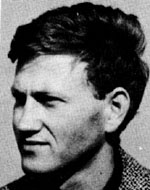Stern, Michael (Mishi)
Son of-David-Zvi and Dora. He was born on November 16, 1935 in Geneva, Switzerland. At the age of ten he was circumcised by his father, who was a mechanical engineer, and then immigrated to Israel with his mother and two sisters; It was after he had attended elementary school in Geneva. When he arrived in Israel, he continued his studies at the son of Shemen Youth Village and later studied at the Municipal High School D and completed his studies in 1954. He was a music lover, read a lot and even reached out to the art of painting. Already at the son of-Shemen Youth Village and in his high school, Michael stood out in his special ways of responding to every request for help and filling out any work he was assigned. In August 1954 he was drafted into the IDF and participated in a number of courses for tank commanders and armored corps officers, and in 1955 he was awarded the “Outstanding Soldier” certificate by the late President Yitzhak son of-Zvi. After the outbreak of the Sinai Campaign in 1956, he took part in it as a platoon commander. Upon completion of his service, he was accepted to the Hebrew Technion in Haifa and studied successfully there at the Faculty of Architecture, a profession he had dreamed about since his childhood and which filled his life with rich content and gave him great satisfaction. At the Technion he was one of the outstanding students in his studies and in his excellent social relations to both his teachers and his friends. He was gentle and modest and did not tell about himself or his work. In 1961 he completed his studies as an architect and went to Switzerland to study. Where he spent two years and in 1964 returned to Israel and began working as an architect in Tel Aviv. Since September 1966, he devoted his time and energy to independent planning. In particular, his aesthetic sensitivity was felt in his approach to architectural solutions in everything around him. He had a sense of self-criticism but did not suffer criticism for his own sake but sought and demanded a constructive approach. He knew how to fight his mind and approach if he was convinced of their justice. He was a pacifist and dreamed of a peaceful settlement in our region. But with the outbreak of the Six-Day War called to reserve duty, went to it and participated in all the battles in the south of the country and in Sinai as a courageous fighter – and fell in the battle that took place on the banks of the Suez Canal on the eve of the liberation of his unit from the service. And two small children, was brought to rest in the military cemetery in Kiryat Shaul, where a large residential building in Geneva, including a community center, was planned, and the people’s home in Rishpon, Sad Flowers, “which was published by the Tel Aviv Municipal High School in memory of its fallen graduates, was devoted to several pages of his life story and some of his letters. In the book “On Your Platforms of Space,” published by comrades in arms, his memory was included in a pamphlet in memory of the fallen people of Ramat Hasharon and also in the journal of the Association of Engineers and Architects.
